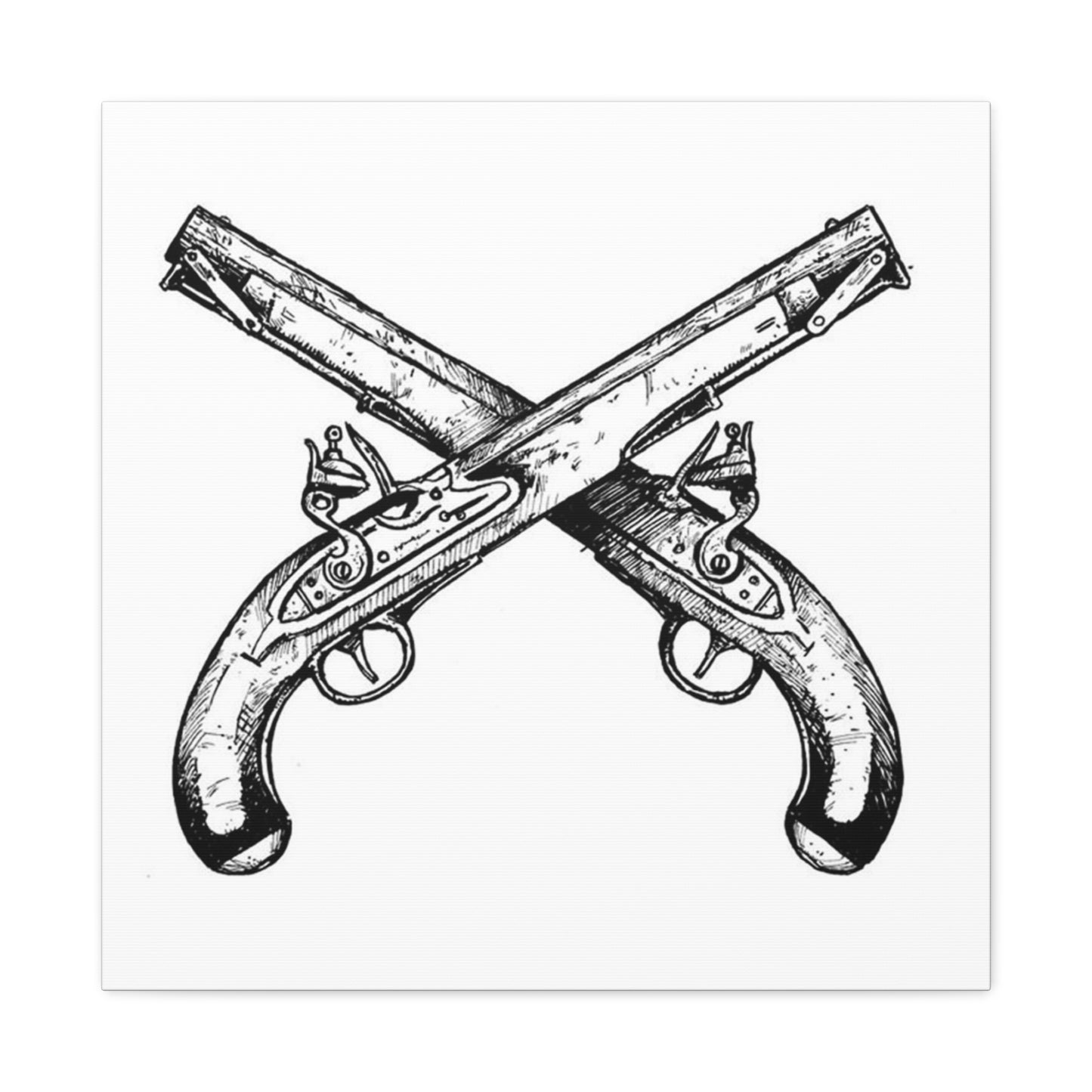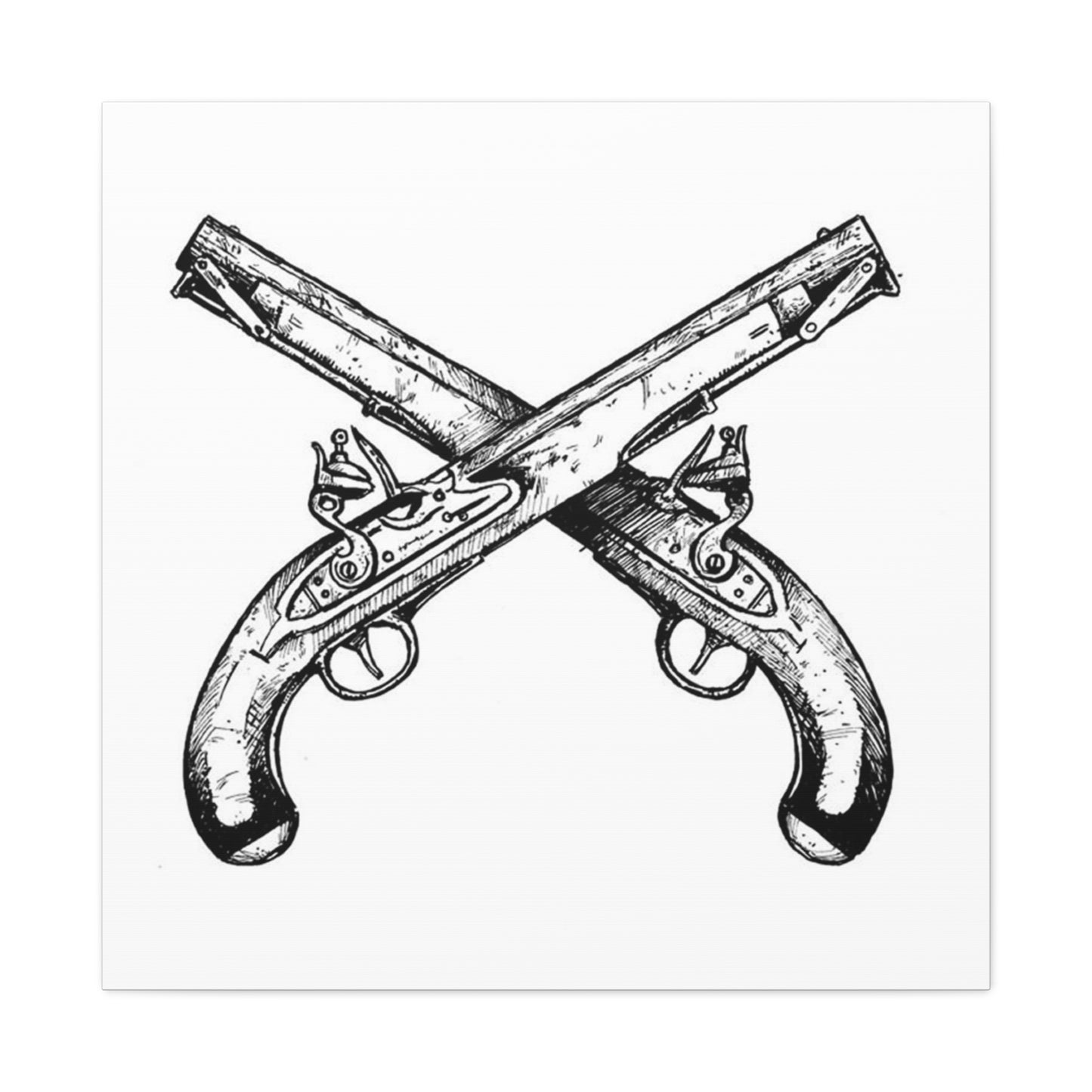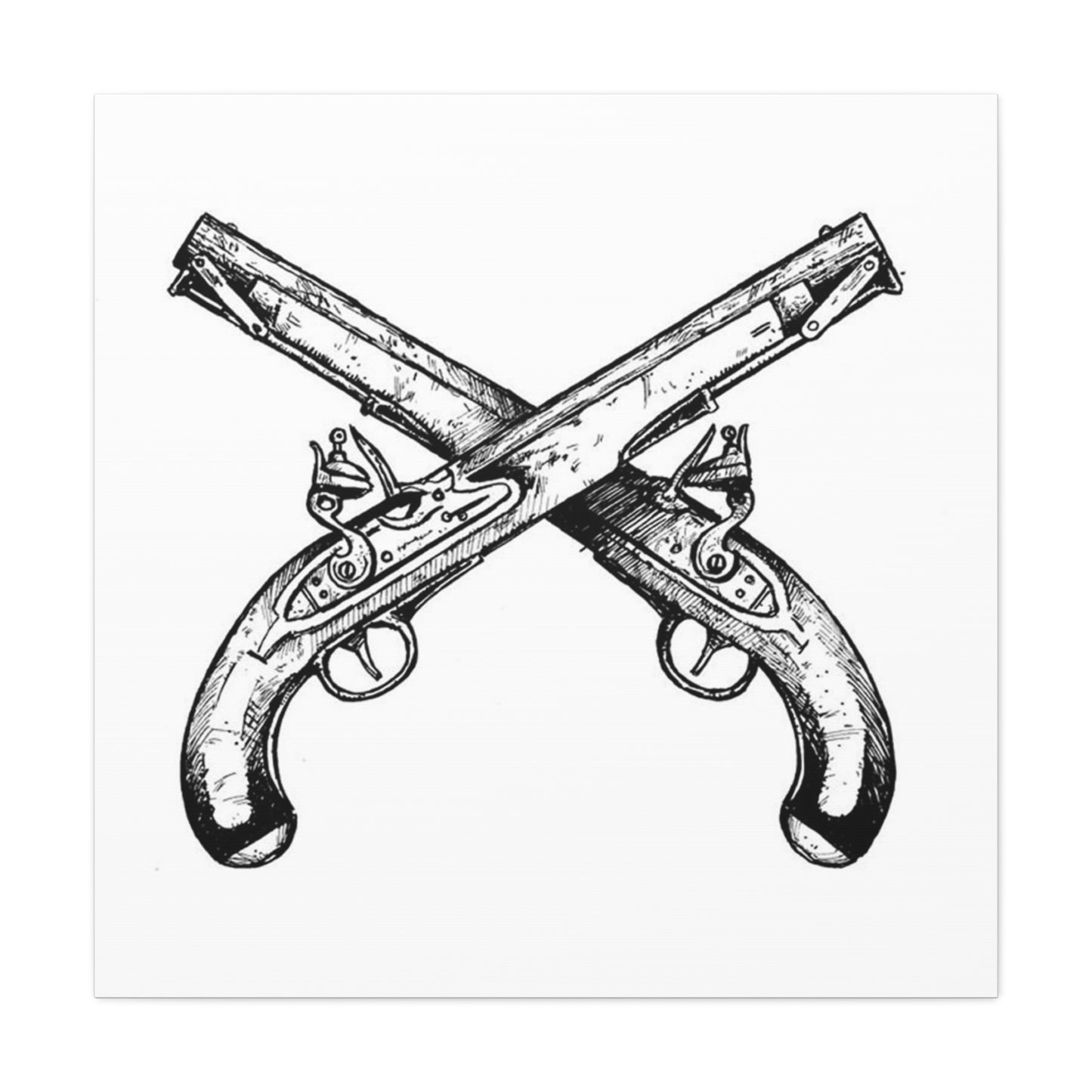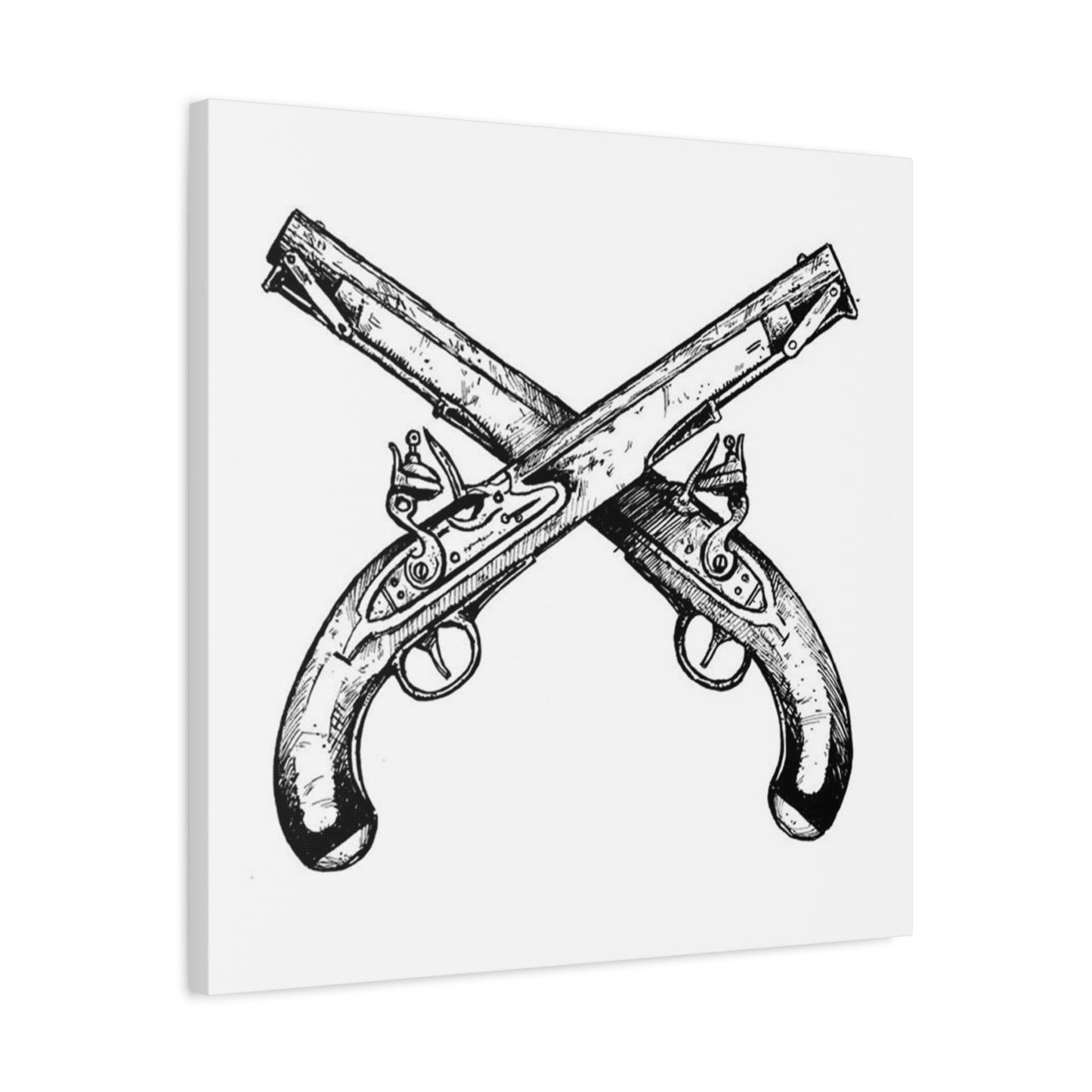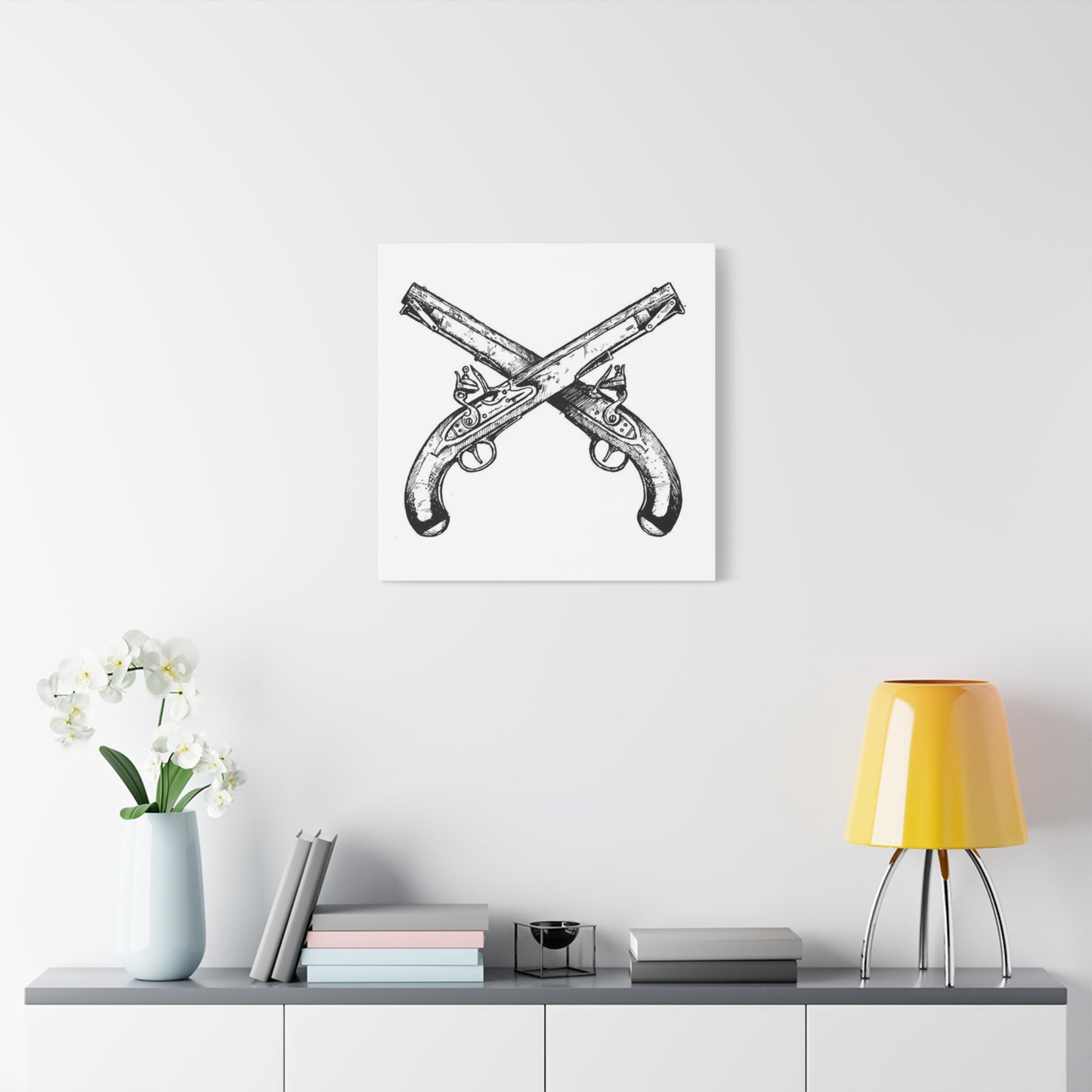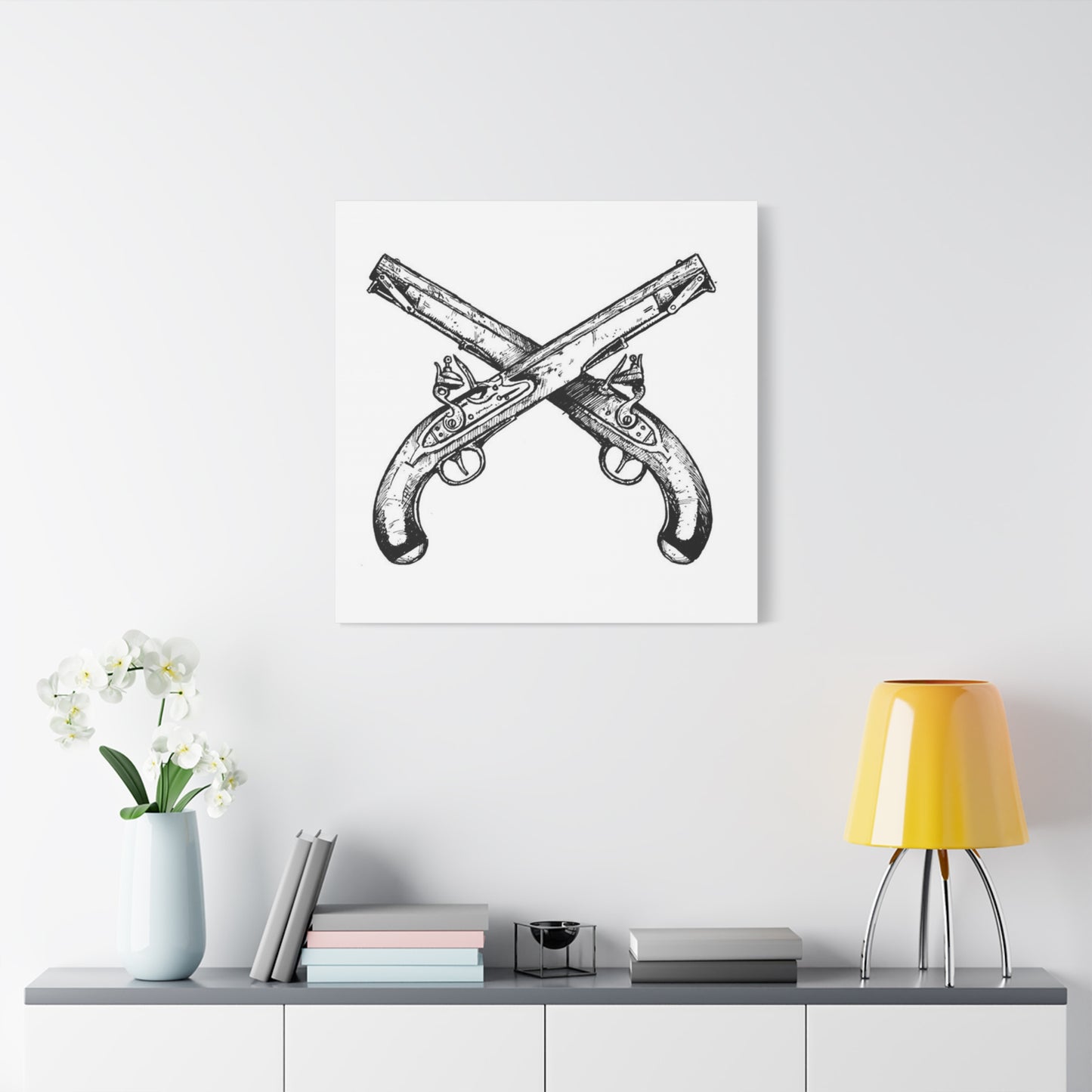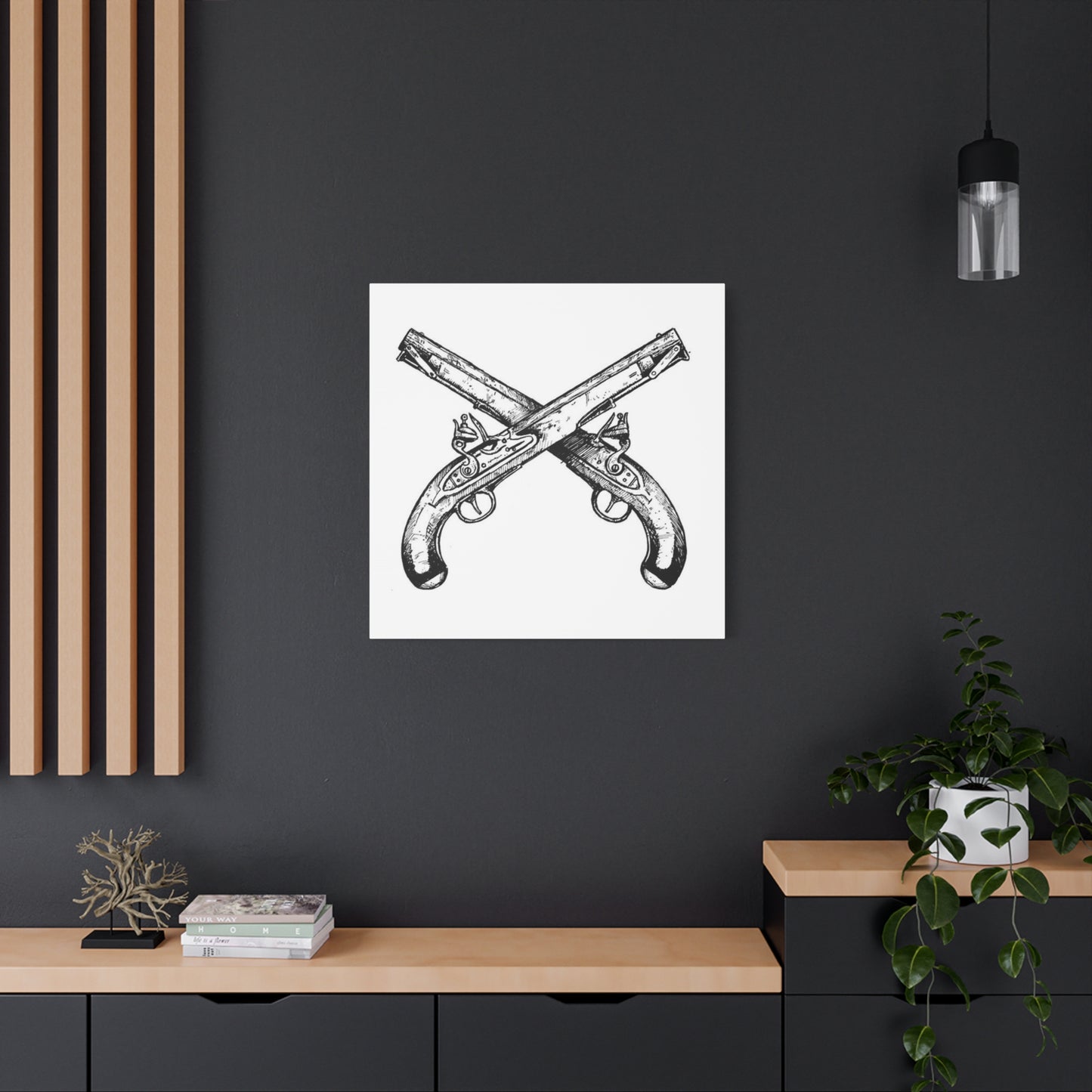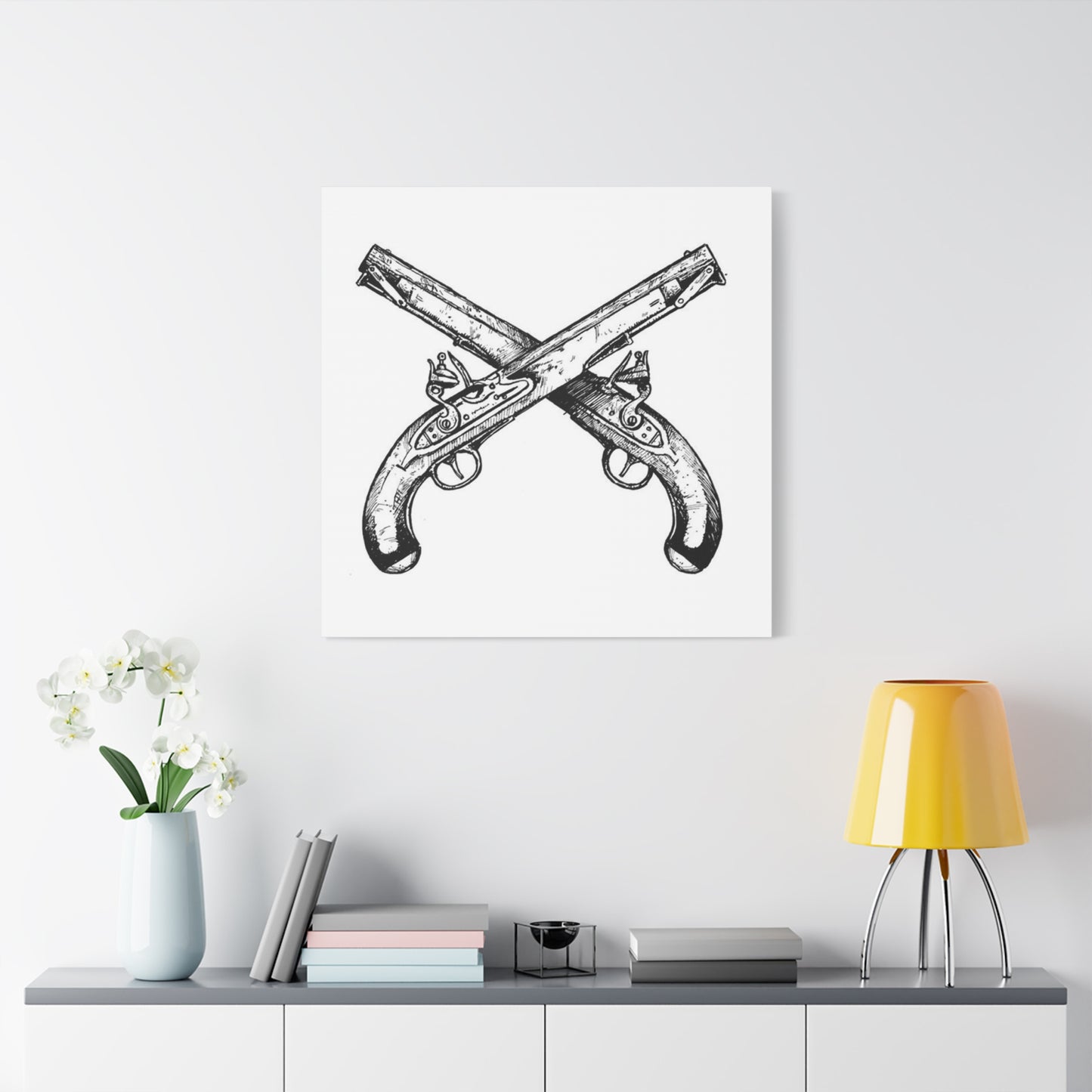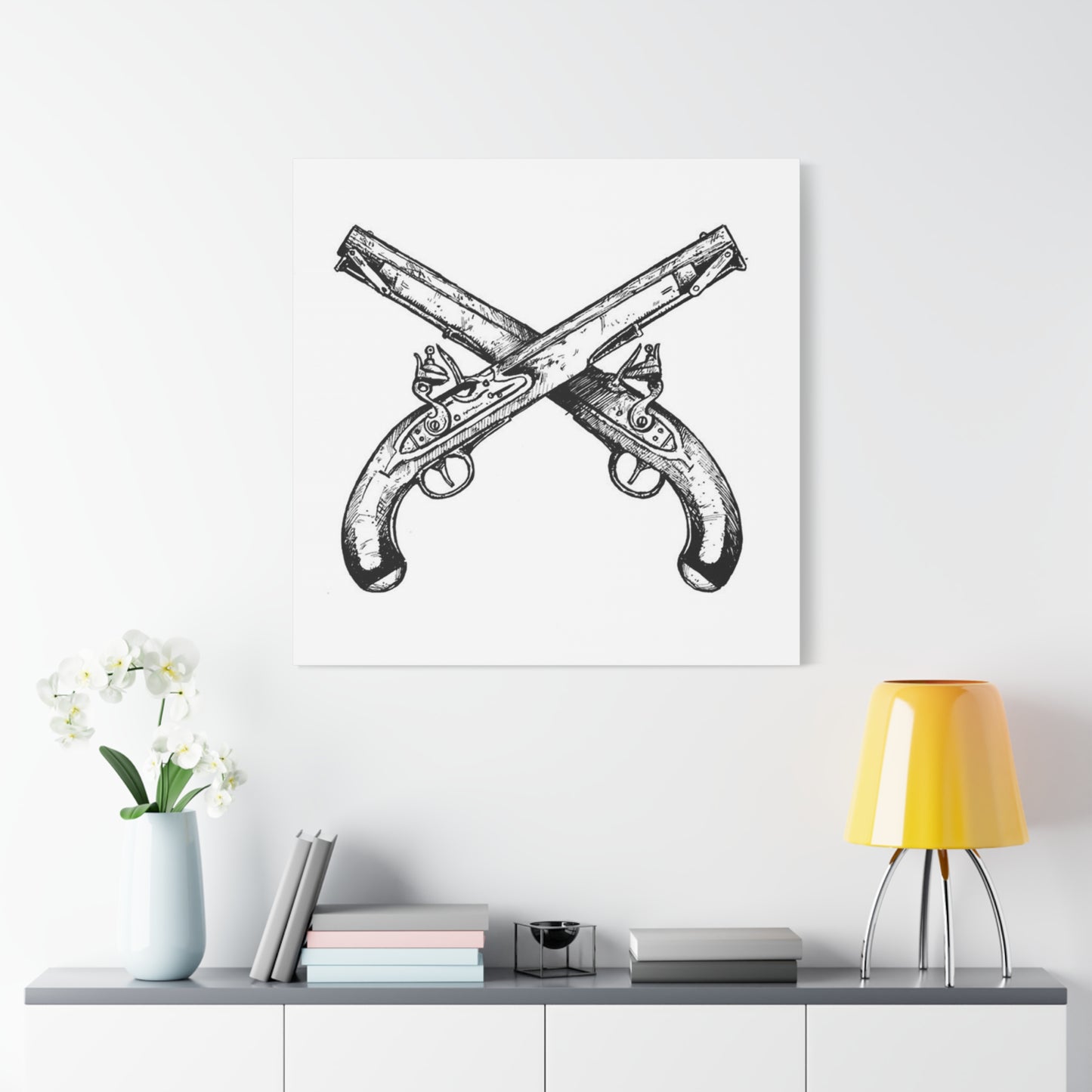Vintage Gun Drawing Wall Art: A Tribute to Classic Firearm Craftsmanship
The world of interior decoration has witnessed a remarkable surge in the popularity of vintage gun drawing wall art canvas prints over recent years. These artistic representations of historic firearms have captured the imagination of collectors, history enthusiasts, and interior designers alike. The appeal of these canvas prints lies in their ability to merge historical significance with contemporary aesthetic sensibilities, creating conversation pieces that resonate with diverse audiences.
Vintage gun drawing wall art canvas prints represent more than mere decorative elements. They embody a fascinating intersection of art, history, and craftsmanship. Each illustration tells a story of innovation, engineering excellence, and the evolution of weaponry through different historical periods. From Revolutionary War muskets to Wild West revolvers, these artistic renditions capture the essence of firearms that shaped nations and influenced the course of human events.
The artistic merit of these canvas prints cannot be understated. Artists who specialize in firearm illustrations employ various techniques to bring these mechanical marvels to life on canvas. Whether rendered in precise technical drawings reminiscent of patent blueprints or interpreted through more artistic lenses with aged paper backgrounds and sepia tones, each piece offers a unique perspective on these historical instruments.
Collectors and decorators are drawn to vintage gun drawing wall art for numerous reasons. Some appreciate the historical significance and the stories behind each weapon depicted. Others admire the intricate mechanical details and engineering prowess evident in the designs. Many find that these pieces add a masculine, sophisticated touch to spaces ranging from home offices and libraries to man caves and hunting lodges. The versatility of these canvas prints makes them suitable for various interior design schemes, from rustic and industrial to traditional and eclectic.
The manufacturing quality of modern canvas prints has elevated these pieces beyond simple posters or prints. High-resolution printing technologies ensure that every detail of the original artwork is preserved with stunning clarity. The use of gallery-wrapped canvases stretched over wooden frames creates a three-dimensional effect that adds depth and presence to the artwork. Many premium options feature hand-embellished details or special finishing techniques that enhance the vintage aesthetic.
Interior designers increasingly recommend vintage gun drawing wall art canvas prints as focal points in masculine spaces or as part of curated gallery walls. These pieces work exceptionally well in rooms with leather furniture, dark wood paneling, and other traditional masculine design elements. However, their appeal extends beyond stereotypically male spaces. The right firearm illustration can complement industrial lofts, farmhouse-style homes, or any space where the occupants appreciate history, craftsmanship, or unique conversation pieces.
The market for vintage gun drawing wall art canvas prints has expanded significantly, with options available at every price point. From affordable reproductions perfect for budget-conscious decorators to limited-edition pieces created by renowned artists, there exists a canvas print suitable for every collection and budget. This accessibility has democratized what was once a niche collecting category, allowing more people to enjoy these historical artistic treasures in their own homes.
As we delve deeper into this comprehensive exploration of vintage gun drawing wall art canvas prints, we will examine the historical context that makes these pieces so compelling, the various artistic styles and techniques employed in their creation, practical considerations for selecting and displaying these works, and the broader cultural significance of firearm art in contemporary society.
Historical Significance of Firearm Illustrations in Art
The tradition of illustrating firearms dates back centuries, with the earliest examples appearing in military treatises and armorer's journals during the Renaissance period. These initial illustrations served primarily functional purposes, documenting weapon designs for replication and study. However, as printmaking technologies advanced, firearm illustrations evolved into an art form appreciated for both technical precision and aesthetic qualities.
During the 18th and 19th centuries, the golden age of firearm illustration emerged. Master engravers created intricate plates for encyclopedias, military manuals, and catalogs produced by gunmakers. These illustrations demonstrated remarkable attention to detail, capturing not only the external appearance of weapons but also their internal mechanisms through exploded views and cross-sections. The artistic skill required to produce these engravings was considerable, with craftsmen spending weeks or months perfecting a single plate.
Patent drawings represent another significant source of historical firearm illustrations. As inventors sought to protect their innovations, they submitted detailed technical drawings to patent offices. These drawings, created with precision and clarity, documented the evolutionary steps in firearm technology. Today, reproductions of these patent drawings have become highly sought after as wall art, appreciated for their combination of historical importance and minimalist aesthetic appeal.
The American West period produced a distinct style of firearm illustration characterized by romanticism and adventure. Artists depicted the iconic revolvers and rifles that came to symbolize frontier life, often placing these weapons in narrative contexts showing cowboys, lawmen, and pioneers. These illustrations contributed to the mythologization of firearms in American culture, transforming practical tools into symbols of independence and self-reliance.
Military conflicts throughout history have generated extensive documentation of weapons through illustration. Official military publications featured detailed drawings of standard-issue firearms, accessories, and ammunition. These illustrations served training and identification purposes, but their artistic qualities have ensured their enduring appeal. World War era weapon illustrations, in particular, have become popular subjects for vintage gun drawing wall art canvas prints, reflecting both historical interest in these conflicts and appreciation for mid-century illustration styles.
The transition from hand-engraved plates to photographic reproduction in the late 19th century marked a significant shift in firearm illustration. However, the artistic tradition continued, with illustrators adapting their techniques to new printing technologies. The early 20th century saw firearm illustrations appearing in sporting magazines, hunting catalogs, and advertising materials, each reflecting the aesthetic sensibilities of their era.
Understanding the historical context of firearm illustrations enhances appreciation for vintage gun drawing wall art canvas prints. Each style and period reflects different artistic movements, technological capabilities, and cultural attitudes toward firearms. Renaissance illustrations emphasized craftsmanship and decoration, with ornately engraved weapons depicted as works of art themselves. Industrial Revolution illustrations focused on mechanical innovation and mass production capabilities. Modern reproductions of these historical illustrations allow contemporary audiences to connect with this rich artistic heritage.
The preservation of historical firearm illustrations through modern canvas prints serves an important cultural function. Many original illustrations exist only in rare books, archival collections, or museum holdings inaccessible to the general public. By reproducing these works as affordable canvas prints, a broader audience can appreciate and study these historical documents. This democratization of access ensures that the artistry and historical significance of firearm illustrations remain part of our collective cultural consciousness.
Artistic Styles in Vintage Gun Canvas Prints
Vintage gun drawing wall art canvas prints encompass a remarkable variety of artistic styles, each offering distinct visual characteristics and emotional resonances. Understanding these different approaches helps collectors and decorators select pieces that align with their aesthetic preferences and complement their interior design schemes.
The technical blueprint style represents one of the most popular approaches to firearm illustration. These pieces mimic the appearance of engineering drawings, complete with precise measurements, exploded views showing internal components, and annotation callouts identifying specific parts. The aesthetic appeal lies in the combination of scientific precision and visual complexity. Typically rendered in white or cream lines against dark blue or black backgrounds, these prints evoke the atmosphere of workshops and design studios where innovation happened. The blueprint style works particularly well in industrial-themed spaces, modern offices, and contemporary masculine interiors.
Patent drawing reproductions constitute another highly sought-after style category. These illustrations replicate the actual drawings submitted to patent offices by inventors seeking to protect their firearm innovations. Characterized by clean lines, minimal shading, and clear presentation of mechanical features, patent drawings possess an austere elegance. Most feature black line work on aged beige or cream backgrounds, sometimes including patent numbers, dates, and inventor names. The appeal of patent drawing style prints extends beyond firearm enthusiasts to anyone who appreciates minimalist design and historical documentation.
Vintage advertising illustration style brings a nostalgic quality to firearm artwork. These pieces reproduce or are inspired by advertisements from the golden age of American gunmaking, roughly spanning the late 19th through mid-20th centuries. Characterized by bold graphics, persuasive text, and idealized depictions of weapons, these illustrations capture the optimism and confidence of their eras. Color palettes often feature warm tones and aged paper effects that enhance the vintage aesthetic. This style works beautifully in retro-themed spaces, game rooms, and collections focusing on American heritage.
The photorealistic illustration style aims to depict firearms with such precision and detail that the artwork resembles high-quality photography. Artists working in this style employ advanced shading techniques, careful attention to texture and material properties, and precise rendering of all visible details. The result creates stunning visual impact, particularly when printed on large-format canvases. Photorealistic firearm illustrations appeal to collectors who value technical artistic skill and desire artwork that showcases weapons in museum-quality detail.
Artistic interpretations offer more expressive approaches to firearm illustration. These pieces prioritize aesthetic considerations over documentary accuracy, incorporating stylistic elements from various art movements. Some artists apply watercolor effects, creating soft, atmospheric renderings of historic weapons. Others embrace bold graphic design approaches with high contrast and simplified forms. Abstract interpretations might fragment or reimagine firearms through cubist or expressionist lenses. These artistic styles appeal to collectors seeking unique pieces that function as fine art rather than historical documentation.
The antique engraving style reproduces the appearance of hand-engraved copper or steel plates used for illustration before modern printing technologies. These pieces feature the distinctive crosshatching, stippling, and line work characteristic of historical engraving techniques. Often printed to simulate aged paper with foxing spots and yellowed tones, these reproductions capture the aesthetic of rare book illustrations. The engraving style works exceptionally well in traditional interiors, libraries, and collections emphasizing historical authenticity.
Silhouette and profile styles offer simplified representations focusing on the distinctive shapes and outlines of firearms. These minimalist approaches work well in modern and contemporary spaces where clean lines and uncluttered design dominate. Black silhouettes against white or neutral backgrounds create striking contrast, while profile views capture the essential character of weapons without overwhelming detail. This style particularly suits situations where multiple pieces will be grouped together, as the consistent simplified approach creates visual coherence.
Mixed media approaches combine photographic elements with illustration, digital effects, and text to create layered, complex compositions. These contemporary interpretations might overlay firearm illustrations with vintage maps, aged documents, or abstract elements. The resulting pieces offer visual richness and complexity, rewarding extended viewing as different layers reveal themselves. This style appeals to collectors who appreciate contemporary art sensibilities applied to historical subject matter.
Choosing the Right Canvas Print Size and Format
Selecting the appropriate size and format for vintage gun drawing wall art canvas prints requires careful consideration of multiple factors including available wall space, viewing distance, room proportions, and the intended visual impact. Making informed decisions about dimensions ensures that the artwork integrates harmoniously with its environment and achieves the desired decorative effect.
Small format canvas prints, typically ranging from eight by ten inches to sixteen by twenty inches, serve specific decorative purposes. These compact sizes work well as components in gallery wall arrangements, where multiple pieces combine to create a larger visual statement. Small vintage gun drawing prints excel in tight spaces such as hallways, bathrooms, or small offices where larger pieces would overwhelm. They also function effectively as accent pieces on bookshelves, mantels, or as part of tabletop vignettes. The intimate scale invites close inspection, making these sizes ideal for highly detailed illustrations where viewers should examine intricate line work and fine details.
Medium format prints, generally spanning eighteen by twenty-four inches to twenty-four by thirty-six inches, represent the most versatile size category. These dimensions provide sufficient presence to serve as focal points in small to medium rooms without dominating the space. A medium-sized vintage gun drawing canvas print works beautifully above a desk, on a feature wall in a den or office, or as part of a symmetrical arrangement flanking a doorway or window. This size range accommodates most firearm illustrations well, providing enough surface area to showcase details while remaining manageable for shipping, handling, and installation.
Large format canvas prints, measuring thirty by forty inches to forty by sixty inches or larger, create dramatic focal points with significant visual impact. These substantial pieces command attention and anchor room designs. Large vintage gun drawing wall art works best in spacious environments with adequate viewing distances. A master bedroom, large living area, or substantial home office provides appropriate contexts for these impressive pieces. When selecting large format prints, consider the level of detail in the artwork. Highly detailed technical illustrations maintain visual interest at this scale, while simpler compositions might appear sparse or empty when enlarged significantly.
Panoramic formats offer unique opportunities for displaying certain types of firearm illustrations. Horizontal orientations in extreme aspect ratios, such as twelve by thirty-six inches or sixteen by forty-eight inches, work exceptionally well for long rifles, muskets, or multiple weapons arranged horizontally. These formats suit installation above sofas, beds, or other horizontal furniture pieces, creating visual balance through proportion repetition. Panoramic vintage gun drawing canvas prints also work effectively in narrow spaces such as stairwell walls or above wainscoting.
Square format canvas prints provide balanced, stable compositions that work in various contexts. Dimensions such as twenty by twenty inches or thirty by thirty inches offer equal visual weight in all directions, making them easy to incorporate into symmetrical design schemes. Square formats work well for single handgun illustrations, detailed close-ups of firearm mechanisms, or artistic compositions centered around a weapon. These prints integrate seamlessly into modern and contemporary interiors where geometric precision matters.
Triptych and multi-panel formats present firearm illustrations across multiple connected canvases, creating dynamic, dimensional displays. A single weapon might span three panels, with the action and firing mechanism centered in the middle panel and the stock and barrel extending into flanking pieces. Alternatively, three different weapons might occupy separate panels while maintaining stylistic consistency. Multi-panel formats add architectural interest to walls and allow for creative installation patterns with spacing between panels affecting the overall aesthetic.
Vintage Guns on Canvas
Vintage guns on canvas capture the elegance, precision, and history of classic firearms, transforming them into striking works of art. These pieces go beyond simple decoration; they celebrate the intricate craftsmanship and engineering brilliance of firearms from bygone eras. Each curve, engraving, and mechanical detail is carefully rendered to highlight the artistry behind these functional objects.
Displaying vintage gun art on canvas allows enthusiasts to honor history while adding character to interiors. Whether hung in a study, library, or man cave, these artworks evoke a sense of nostalgia and respect for the meticulous design of classic firearms. From revolvers and rifles to antique pistols, every illustration tells a story of innovation, style, and historical significance.
Modern artists often use a mix of detailed line work, sepia tones, and realistic shading to bring these weapons to life on canvas. Some interpretations focus on technical schematics, showing exploded views and internal mechanisms, while others emphasize the aesthetic beauty of the gun’s exterior. This blend of precision and artistry makes vintage gun canvas art appealing not only to collectors but also to those with an appreciation for industrial design and mechanical elegance.
In addition to their historical and artistic value, vintage gun canvases can complement a variety of interior styles—from rustic and industrial to modern minimalist. They serve as conversation starters, reflecting both personal interests and an admiration for timeless craftsmanship. By bringing vintage firearms to canvas, artists preserve a unique cultural and technical legacy, transforming it into a visually compelling centerpiece for any room.
Retro Gun Sketch Decor Wall Art
Retro gun sketch wall art brings the timeless beauty of classic firearms into modern spaces. Combining historical craftsmanship with artistic interpretation, these pieces transform vintage guns into striking visual statements that suit both contemporary and traditional interiors.The appeal of retro gun sketch wall art lies in its attention to detail and technical precision. Artists often use clean lines, monochrome tones, and schematic-inspired designs to capture the elegance and mechanical complexity of revolvers, rifles, and antique pistols. Some sketches highlight engraved patterns and textures, while others explore the inner workings of firearms, offering both artistic flair and educational insight.
This type of wall art works perfectly in studies, offices, libraries, or living rooms, adding a touch of sophistication and nostalgia. It pairs well with industrial, vintage, and rustic décor, creating a space that reflects both personal style and a respect for historical craftsmanship. Retro gun sketches can also serve as conversation starters, appealing to collectors, history enthusiasts, or anyone fascinated by mechanical artistry.
By turning classic firearms into wall art, these pieces celebrate engineering, history, and design simultaneously. They preserve the legacy of vintage guns while transforming functional objects into visual masterpieces.Whether displayed individually as a statement piece or as part of a gallery wall, retro gun sketch décor elevates a room with elegance, character, and a sense of timeless artistry. It’s more than decoration—it’s a tribute to the craftsmanship and enduring appeal of vintage firearms.
Popular Firearm Types Featured in Wall Art
Vintage gun drawing wall art canvas prints encompass a vast array of firearm types, each with distinct visual characteristics and historical associations. Understanding the popular categories helps collectors identify pieces that resonate with their interests and complement their collecting themes.
Revolutionary War era muskets and rifles represent some of the earliest firearms featured in wall art. These long guns, including Brown Bess muskets, Pennsylvania long rifles, and French Charleville muskets, played crucial roles in American independence. The elegant lines of these weapons, with their lengthy barrels and wooden stocks, create striking vertical or diagonal compositions. Illustrations often emphasize the craftsmanship evident in hand-forged components and hand-carved stocks. These pieces appeal to history enthusiasts and patriots who appreciate Revolutionary War heritage.
Wild West revolvers dominate vintage gun drawing wall art due to their iconic status in American culture. Colt Single Action Army revolvers, commonly called Peacemakers, remain the most recognizable and frequently illustrated handguns. Smith and Wesson revolvers, particularly the Schofield model, also appear regularly. These six-shooters symbolize the frontier era, evoking images of lawmen, outlaws, and cowboys. The compact, elegant forms of these revolvers translate beautifully to canvas prints, and their cultural significance makes them conversation pieces in any setting.
Winchester lever-action rifles represent quintessential American firearms with tremendous appeal for wall art collectors. The Winchester Model 1873, famously called the gun that won the West, features prominently in vintage gun drawing illustrations. The distinctive lever action mechanism, tubular magazine beneath the barrel, and classic proportions create visually balanced compositions. These rifles symbolize American innovation, frontier expansion, and the golden age of Western settlement. Illustrations capturing the mechanical elegance of lever-action operation hold special appeal for those who appreciate functional design.
Military rifles from the World Wars generate significant collector interest. Springfield Model 1903 rifles, M1 Garand rifles, and various bolt-action infantry weapons appear frequently in vintage gun drawing wall art. These firearms represent pivotal moments in history and honor the sacrifices of servicemembers. Technical illustrations showing the complex mechanisms of these weapons appeal to military history enthusiasts and veterans. The historical weight carried by these pieces adds emotional resonance beyond mere aesthetic appeal.
Antique dueling pistols and flintlock weapons offer ornate decorative qualities. These elaborately embellished firearms often featured engraving, inlay work, and artistic metalwork that elevated them to objets d'art. Illustrations highlighting these decorative elements create visually rich compositions suitable for traditional and elegant interiors. The association with aristocratic culture and codes of honor adds romantic historical context to these pieces.
Shotguns, particularly classic side-by-side double barrels and early pump-action models, appeal to hunting and sporting enthusiasts. Vintage gun drawing illustrations of shotguns often emphasize their practical elegance and connection to outdoor pursuits. These pieces work beautifully in hunting lodges, cabins, and homes of sportsmen who appreciate heritage firearms used for generations of bird hunting and clay shooting.
Pocket pistols and derringers offer compact subjects for smaller format canvas prints. These diminutive weapons carry associations with gambling, the Old West, and personal protection in an era before modern concealed carry. The small size of these firearms allows artists to showcase intricate details in close-up compositions, and their hidden weapon mystique adds intrigue to the artwork.
Machine guns and automatic weapons from the 20th century provide dramatic subjects for modern military history collections. Thompson submachine guns, Browning automatic rifles, and various crew-served weapons represent technological innovation and industrial warfare. These complex weapons create visually busy, detail-rich compositions that work well in large format prints where the mechanical complexity can be fully appreciated.
Color Schemes and Aesthetic Options
The color palette and overall aesthetic treatment significantly influence how vintage gun drawing wall art canvas prints integrate with interior design schemes. Understanding available options helps collectors select pieces that harmonize with existing decor while achieving desired atmospheric effects.
Monochromatic black and white presentations offer timeless elegance and maximum versatility. These high-contrast illustrations work in virtually any interior design context, complementing both modern minimalist spaces and traditional environments. Black line work against white or cream backgrounds creates clean, crisp images that highlight the mechanical details of firearms without color distraction. This approach works particularly well for patent drawing reproductions and technical blueprint styles. The neutral palette ensures these pieces never clash with room color schemes, making them safe choices for spaces that might undergo future redecoration.
Sepia tones and aged paper effects create authentic vintage aesthetics. These warm brown tones evoke antique photographs and historical documents, immediately establishing period atmosphere. Sepia-toned vintage gun drawing canvas prints work beautifully in traditional interiors, libraries, and spaces decorated with antique furniture and rich wood tones. The aged appearance suggests the artwork itself possesses historical provenance, enhancing the connection between viewer and historical subject matter. Variations in aging effects from light tan to deep brown allow matching with different wood finishes and warm color palettes.
Blueprint blue backgrounds with white or cream line work create distinctive technical drawings that reference engineering and design processes. The rich blue shade, ranging from navy to lighter azure, adds color interest while maintaining the historical association with architectural and mechanical drawings. Blueprint style vintage gun drawing wall art canvas prints work exceptionally well in industrial-themed spaces, modern offices, and masculine interiors. The blue color provides enough visual interest to serve as a focal point while remaining subdued enough not to overwhelm.
Earth tones including olive greens, browns, and tan shades connect with military heritage and outdoor sporting traditions. These muted natural colors complement rustic interiors, hunting lodges, and spaces decorated with leather furniture and natural materials. Earth-toned backgrounds allow black line work to remain visible while creating warmer presentations than stark white backgrounds. This palette particularly suits illustrations of military firearms and hunting weapons where the color associations reinforce the subject matter.
Parchment and antique document backgrounds replicate the appearance of aged paper complete with yellowing, foxing spots, and surface irregularities. These textured backgrounds add visual complexity and historical authenticity. The imperfections inherent in aged paper create visual interest without competing with the primary firearm illustration. Parchment backgrounds work well when displaying multiple prints together, as the varied aging patterns prevent visual monotony while maintaining stylistic consistency.
Dramatic dark backgrounds create bold contrast and modern appeal. Black, charcoal gray, or deep navy backgrounds allow white or metallic line work to pop dramatically. This high-contrast approach suits contemporary interiors and creates striking visual impact. Dark background vintage gun drawing canvas prints work particularly well in rooms with dark accent walls or when mounted against light-colored walls where the dark print creates strong definition. This treatment emphasizes the silhouettes and outlines of firearms while obscuring fine interior details.
Creating Gallery Walls with Firearm Illustrations
Gallery walls featuring vintage gun drawing wall art canvas prints create dynamic, visually engaging displays that showcase collections while making powerful design statements. Successful gallery wall creation requires careful planning regarding composition, spacing, and thematic consistency.
Planning begins with selecting the wall space and measuring its dimensions. Ideal gallery wall locations include large empty walls in living rooms, hallways, stairwells, and offices. The space should allow viewers to step back and appreciate the entire arrangement while also permitting close inspection of individual pieces. Photograph the wall area and create a floor template using craft paper or newspaper cutouts representing each canvas print. This physical planning eliminates trial-and-error hanging and prevents unnecessary wall damage.
Selecting pieces for gallery walls requires balancing unity and variety. Thematic consistency ensures coherence while varied sizes and orientations prevent monotony. Consider grouping firearms from the same historical period, featuring works by the same artist, or maintaining consistent color palettes across all pieces. A gallery wall might showcase different views of a single weapon type, trace the evolution of a particular firearm design across decades, or present an array of weapons from a specific conflict or era.
Composition approaches range from structured grid arrangements to organic salon-style layouts. Grid arrangements feature consistent spacing between identically sized prints, creating orderly, modern presentations. This approach works well with technical drawings and patent reproductions where visual consistency reinforces the systematic nature of the subject matter. Salon-style arrangements feature varied sizes and orientations with asymmetrical spacing, mimicking the eclectic displays of 19th-century art salons. This approach allows incorporation of diverse piece sizes and creates more casual, collected-over-time aesthetics.
Spacing between prints significantly impacts visual impact. Tighter spacing, typically two to three inches between frames, creates unified visual blocks where the collection reads as a single entity. Wider spacing, four to six inches apart, allows each piece individual breathing room and works better when prints vary significantly in size or style. Consistent spacing throughout the arrangement creates professional polish, while varied spacing suggests more organic, evolving collections.
Anchor pieces establish focal points around which gallery walls organize. Large format vintage gun drawing canvas prints or particularly significant illustrations serve as visual anchors, typically positioned centrally or slightly off-center according to design principles. Surrounding pieces balance the anchor both visually and thematically. When multiple focal points exist, distribute them to prevent competition for attention and create visual flow guiding viewers through the entire arrangement.
Periods and Their Distinctive Firearms
Different historical eras produced firearms with distinctive characteristics that translate into visually diverse vintage gun drawing wall art canvas prints. Understanding these periods enhances appreciation for the weapons depicted and guides thematic collecting approaches.
The matchlock era, spanning the 15th through 17th centuries, introduced the first practical portable firearms. Matchlock muskets and arquebuses featured simple firing mechanisms using smoldering cord to ignite powder. These early weapons possessed crude, handcrafted qualities with minimal standardization. Illustrations of matchlock firearms showcase the primitive technology that revolutionized warfare despite significant limitations. The long barrels, heavy construction, and ornate decorative elements on quality examples create visually impressive subjects. Collectors interested in the earliest portable firearms find matchlock illustrations compelling for their historical significance and distinctive appearance.
The flintlock period, dominating from the 17th through early 19th centuries, refined firearm technology significantly. Flintlock muskets, rifles, and pistols used sparking flint to ignite priming powder, creating more reliable ignition than matchlocks. This era saw extensive military standardization as nations equipped armies with pattern-standard weapons. Brown Bess muskets, Charleville muskets, and various rifle patterns defined military firearms. Civilian firearms included elegant dueling pistols, pocket pistols, and hunting long guns. Vintage gun drawing wall art featuring flintlock weapons captures this refined era when firearm craftsmanship reached artistic heights. The visible mechanisms and elegant proportions make flintlock illustrations particularly attractive.
The percussion cap era, spanning roughly 1820 to 1870, introduced the copper percussion cap that dramatically improved reliability and weather resistance. This technological leap enabled practical revolving cylinder pistols, leading to the revolver revolution. Early percussion revolvers by Colt, Remington, and others transformed personal defense and cavalry warfare. Percussion rifles including Plains rifles, Hawken rifles, and early military patterns served civilians and soldiers. The transition period between flintlock and cartridge firearms produced diverse designs as inventors experimented with new technologies. Canvas prints featuring percussion firearms capture this dynamic era of rapid innovation.
The cartridge era beginning in the 1860s revolutionized firearms through self-contained metallic cartridges combining projectile, powder, and primer. This innovation enabled practical repeating firearms and dramatically increased firepower. The post-Civil War period through the turn of the 20th century represented the golden age of American firearms development. Lever-action rifles, single-action revolvers, double-action revolvers, and early semi-automatic pistols appeared in rapid succession. This extraordinarily creative period produced iconic weapons that dominate vintage gun drawing wall art. Winchester rifles, Colt revolvers, and Smith and Wesson handguns from this era carry tremendous cultural significance and recognition.
Interior Design Ideas Using Vintage Gun Wall Art
Vintage gun wall art offers a unique blend of history, craftsmanship, and visual appeal, making it a striking addition to a variety of interior spaces. These artworks, often featuring detailed sketches, schematics, or artistic renderings of classic firearms, can elevate a room with sophistication, character, and a touch of nostalgia.
One popular approach is to create a study or home office inspired by vintage firearms. A large vintage gun canvas or a set of framed sketches can serve as the focal point above a desk or bookshelf. Pairing the art with dark wood furniture, leather seating, and industrial lighting enhances the masculine and classic feel of the space. This style works particularly well for collectors or enthusiasts who appreciate both history and mechanical precision.
For a more modern and minimalist setting, consider using monochrome firearm sketches. These can be displayed in a gallery-style arrangement with clean lines and neutral walls. This approach emphasizes the artistic and structural beauty of the guns without overwhelming the space. Adding subtle metallic accents or industrial décor elements complements the mechanical theme of the artwork.
In living rooms or entertainment areas, vintage gun wall art can serve as a statement piece. Large-scale pieces above a fireplace or sofa instantly draw attention and spark conversation. For a cohesive look, incorporate complementary textures such as exposed brick, concrete, or distressed wood, which echo the historical and rugged nature of the firearms depicted.
Finally, for a more casual or eclectic vibe, mix vintage gun sketches with other historical or mechanical art. Layering prints of antique maps, blueprints, or tools alongside firearm illustrations creates a curated, museum-like atmosphere that celebrates craftsmanship across different mediums.Overall, vintage gun wall art is versatile, bridging history, artistry, and interior design. Whether your style is traditional, industrial, or contemporary, these pieces can transform ordinary walls into captivating displays of mechanical elegance and timeless design.
Conclusion:
In a world driven by modern technology and rapid innovation, vintage gun drawing wall art stands as a powerful tribute to the artistry, precision, and history of classic firearm craftsmanship. These artworks capture more than mechanical form—they encapsulate the essence of design excellence and the spirit of a bygone era when functionality met fine artistry. Through detailed sketches, etchings, and blueprint-style renderings, vintage firearm art transforms technical mastery into timeless visual storytelling.
At its core, this form of wall art celebrates craftsmanship—the meticulous attention to proportion, symmetry, and engineering that defined the golden age of gunsmithing. Each line in a vintage drawing tells a story of innovation and dedication, reflecting an era when weapons were not just tools but masterpieces of metalwork and design. By bringing these drawings into your home or workspace, you honor both history and human ingenuity, creating a dialogue between art, tradition, and technology.
From an interior design perspective, vintage firearm wall art adds a unique touch of sophistication and historical intrigue. Its monochrome palette and fine linework complement industrial, rustic, or masculine décor themes, blending effortlessly with wood, leather, and metal textures. Whether displayed as a single statement piece or as part of a curated gallery wall, these artworks bring structure and refinement to any space. They work beautifully in offices, studies, libraries, or living rooms—spaces where intellect, heritage, and aesthetics converge.
But beyond aesthetics, these artworks evoke reverence for the craftsmanship and engineering heritage behind each firearm. The drawings often showcase not the weapon’s destructive potential but its beauty as a feat of mechanical art. The balance of curves, levers, and engravings reveals the deep respect early gunsmiths had for precision and performance. Framed and displayed, such artwork speaks to the viewer’s appreciation of history, craftsmanship, and the evolution of design itself.
Emotionally, vintage gun art appeals to collectors, historians, and design enthusiasts alike. It connects them to eras of exploration, invention, and mastery. For many, these images symbolize resilience, discipline, and creativity—qualities embodied by artisans who dedicated their lives to perfecting each component by hand. In this way, the art becomes both educational and inspiring, bridging the past with the present through the timeless language of technical drawing.
Furthermore, the artistic reinterpretation of firearms offers a new perspective on legacy. Rather than glorifying weaponry, it celebrates precision and design integrity, transforming objects of function into icons of form. It’s this shift—from tool to artwork—that allows vintage gun drawings to transcend their mechanical origins and enter the realm of fine art. They remind us that even the most utilitarian creations can possess beauty, symmetry, and cultural depth.
Ultimately, Vintage Gun Drawing Wall Art is a tribute—to heritage, craftsmanship, and the pursuit of perfection. It elevates historical design to a modern context, where each framed sketch becomes a symbol of discipline, innovation, and timeless artistry. In displaying such works, you’re not just appreciating vintage aesthetics—you’re preserving a piece of creative history that continues to inspire precision, respect, and admiration for generations to come.

















